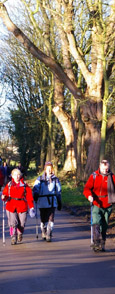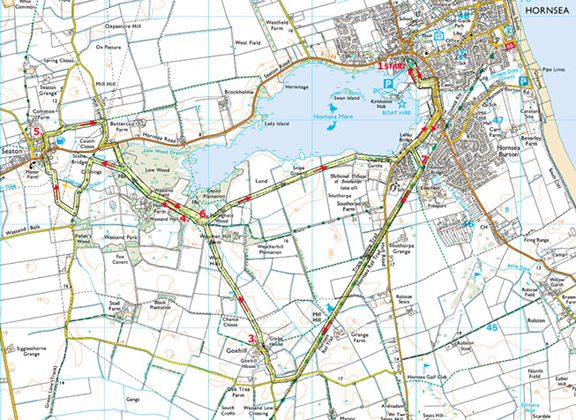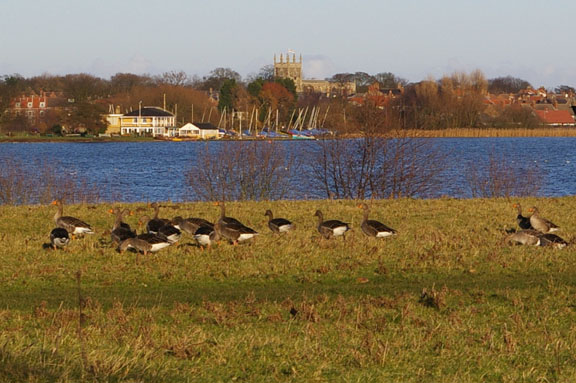
|
EAST YORKSHIRE - Hornsea - 13km (8½miles)
'Wassand Loop'
An easy stroll from Hornsea via the Rail Trail to Goxhill, followed by a loop to Seaton through Wassand Woods and a return overlooking the Mere.
Fact File
|
Distance
|
13km (8½miles)
|
|
Terrain
|
Field paths, tracks & minor roads
|
|
Time
|
3 ½ hours
|
|
Stiles
|
5
|
|
Grading
|
** easy
|
|
Suitable for
|
all
|
|
Start/Parking
|
Hornsea Mereside |
|
Nearest Town
|
Hornsea
|
|
Refreshments
|
Swan Inn, Seaton, and pubs and cafés (some seasonal) in Hornsea
|
|
Toilets |
none
|
|
Public Transport
|
East Yorkshire 240 & 246 Hull & Beverley to Hornsea (via Seaton). Other buses serve Hornsea from Withernsea and Bridlington (some seasonal)
|
|
Map
|
OS Explorer 295
|


Route created using TrackLogs Digital Mapping
Image reproduced with kind permission of Ordnance Survey and Ordnance Survey of Northern Ireland.

- (Start) From the Mereside parking area walk east along the road continuing along an unadopted section to reach the access drive to Hornsea Mere. Turn left along to the road and there turn right. Keep to the pavement turning right along Hull Road. Walk along here for about 400m with the Mere on your right. Cross to the left hand side of the road and at a footpath sign turn up a grassy track through allotments. At the top turn right through a barrier to gain the Hornsea Rail Trail/Trans-Pennine Trail.
- (1.6km, 1mile) This disused railway is almost dead straight for several miles. With its asphalt surface it is now a popular route from Hull and is the final section of the Trans-Pennine Trail from Southport. Be aware of other users – particularly cyclists! Initially the track is in a cutting and it passes under the bridge carrying Hull Road, but after that the countryside becomes more open, although the old line is almost continuously bordered by trees and bushes. About 1.5km (1 mile) beyond the bridge the track encounters a road crossing. Turn right here along this minor road, and then right again at a cross roads to follow a lane past a pond into the hamlet of Goxhill. Here take the opportunity to visit the unusual little church.
- (4.0km, 2½miles) Go through the gate adjacent to the church and head diagonally across the field following a tractor track along the edge of the next field. It can be very wet and muddy on this section! At the next field, the footpath continues straight across – a strip is usually left uncultivated for this – to a stile in the hedge. Cross the next field maintaining direction to another stile. These fields are used for grazing and you are liable to encounter inquisitive cattle at any time. Continue through two more fields and the path eventually merges with the bridleway through Wassand.
- (5.6km, 3½miles) Go though a gate and continue along the track, crossing an open stretch which permits Wassand Hall on your left an uninterrupted view of the Mere on the right. Through another gate you come to a delightful avenue – this being particularly attractive in early spring and late autumn. As you approach the Lodge Cottage look out for a path heading diagonally left through a small wood and into an open field. Walk up the field with pond to your right. This field is very hummocky – evidence of old earthworks or stone or gravel pits. Halfway up the field, the path crosses a sunken green lane. Turn left down this track leaving the field at a gate. Immediately turn right along a tractor track along the bottom of a field, following the field edge round to a plantation (note: the actually right-of-way comes across this field from further up the lane, but can be very muddy and difficult to trace). A grassy path right takes you round this plantation to a footpath gate. A newly enclosed path leads you up through a tree nursery and past cottages to the centre of Seaton. Cross the road with care to reach the Swan Inn.
- (7.4km, 4¾ miles) From the back of the Swan Inn, walk past bungalows and round the corner along Bewholme Lane. At the next bend (FPS) go through gate and keep along the edge of a field, crossing a footbridge, to reach another lane with an electricity sub-station over to the right. (You could continue straight on along field paths, behind Buttercup Farm and Brockholme, and return to Hornsea along Seaton Road) However a more attractive route is to loop back through Wassand. So turn right along the lane down to the main road. Go left down the pavement for about 100m and cross to join the driveway to Wassand Hall. Follow the drive past Lodge Cottage back along the avenue, past the Hall, to gates at the corner of woodland on your left.
- (9.8km, 6¼Miles) Go left through the footpath gate and head diagonally across the field to another gate. These low-lying pastures can be quite squelchy at times. The footpath now maintains an easterly direction from field to field, with Mere on your left. Sheep or cattle may be encountered anywhere along this stretch. As you approach Hull road there is a fine view across the Mere, with Hornsea Parish Church beyond. At Hull road retrace your steps back to your car at Mereside. (13km, 8½ miles)
Along the Way
Wassand Hall is a fine Regency House in beautiful tranquil surroundings between Seaton and Hornsea. The Estate has been in one family ownership since 1530 and enjoys beautiful walled gardens, woodland walk and half-mile park walk with views of Hornsea Mere which belongs to the Estate. The Hall contains a collection of 18th and 19th century paintings and portraits of past owners of Wassand Hall and their relations; a collection of English and European silver, furniture and porcelain from the same period.
The house, gardens and parks are open on selected days during the summer, when teas are available in the fine conservatory.
Hornsea Mere is the largest freshwater lake in Yorkshire and was formed at the end of the Ice Age. Due to its closeness to the North Sea, the lake attracts a variety of wintering birds including gadwalls, golden-eyes, and tufted ducks. The Mere's reed-beds provide breeding sites for hundreds of pairs of reed warblers.
Arnold Underwood with Leven Walking Club (Dec 2006)
|




